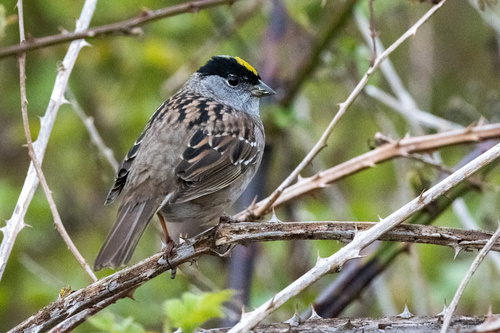Deep in the night, flocks of golden-crowned sparrows (Zonotrichia atricapilla) resemble bright stars, their golden forehead jewels an emblem of celestial connection. The moving star cluster soars through the darkness, eyes set on true constellations above. The sparrows are nearly at the end of their annual journey southward from western Canada and Alaska to California, and have flown almost 3,000 miles, largely relying on far-away star pinpoints as nighttime guides.
Though they have tried to follow the shoreline below, winds gently push some of the birds away over the open ocean—only silvery moonlit water visible.
It is the wee hours of the morning. Wingbeat after wingbeat, the birds tire and they wonder when they will see land again.
“No gold here,” tweets one sparrow at the silvery expanse.
“Oh, dear me,” whistles another.
“I’m so tired,” sings Weary Willie with a melancholic, undulating song.1
These golden-crowned sparrows are just a few of the hundreds of thousands—sometimes millions—of night-migrating birds which make their great flight during the spring and fall. In fact, most birds are nocturnal migrants, including species of hummingbirds, cuckoos, herons, orioles, warblers, vireos, and sparrows. In addition to smell, landmarks, and magnetoreception, the birds are guided by a “star map” which they learn through the power of observation.
In 1967, Stephen Emlen raised a group of indigo buntings—also nighttime migrants—inside of a small planetarium nestled in the center of Flint, Michigan. Here, he exposed the birds to a projected artificial sky and experimented with covering some parts of the sky and leaving others exposed. Through this process, he learned that the buntings orient themselves by identifying patterns of stars which move the slowest. Stars closest to the poles (north-south) move the least, which includes polaris—the North star.
The golden-crowned sparrows continue to flap southwards, still no land in sight. Above them, they notice rings of motion, steadfastly spiraling across the black fabric of the universe.
When Emlen altered the projection to simulate a circumstance in which Earth’s axis was different—resulting in a false sky which rotates around Betelgeuse rather than the North star—the birds took Betelgeuse on as their new North, confirming that they indeed use the speed of star rotation, rather than specific star patterns, to learn direction. Emlen concluded that young indigo buntings build a mental “sky map” detailing where the center of rotation is located, providing them a tool to migrate north-south on their first migration along the Pacific flyway. It is likely that this is also one navigational tool for many other species of migratory birds, including the weary golden-crowned sparrows.

Photo by Marsha Kirshbaum

steve_ha / iNaturalist
Just as daylight begins to break through the darkness, the golden-crowned flock spots land projecting out into the ocean—the headlands of Point Reyes National Seashore, their final destination. Bone-weary, they fall to the few windswept trees and the red-roofed lighthouse.
They’ve made it.
For many night-migrating birds, the Point Reyes Lighthouse and the Point Reyes Headlands— which sticks ten miles out into the sea—is the first piece of land that they see as the sun is rising: “I remember being out at the Point Reyes Lighthouse early in the morning and seeing a few migrants just seem to drop out of the sky, landing for the first time after a long night’s flight.” says Mark Dettling, avian biologist at Point Blue Conservation Science. “It’s just wild to think of such small birds making these huge journeys.”
After some rest, the golden-crowned sparrows will head towards their preferred brushy habitat in and around the Seashore, where they will live for the winter. Some of the sparrows may decide to continue night-flying down south, as far as Baja California. Each sparrow’s site fidelity largely depends on how many of their flockmates from previous years—fellow stars in their feathery constellation—return with them. The more golden-crowns which remain together from past migratory journeys, the more likely they are to resettle in old wintering locations—often taking up residence just 100 feet away from their former ranges.
As it turns out, both the movement of constellations in the winter sky and the constellation of connections formed with their flockmates help golden-crowned sparrows find their home under the cover of night.
_______________________
Footnotes:
1 These are phrases birders have used to identify golden-crowned sparrows’ songs. During the gold rush, miners nicknamed the bird “Weary Willie,” and to them, the song sounded like the bird was saying “I’m so tired.” Other miners heard the song as “no gold here.”

Anela Kopshever / NPS



